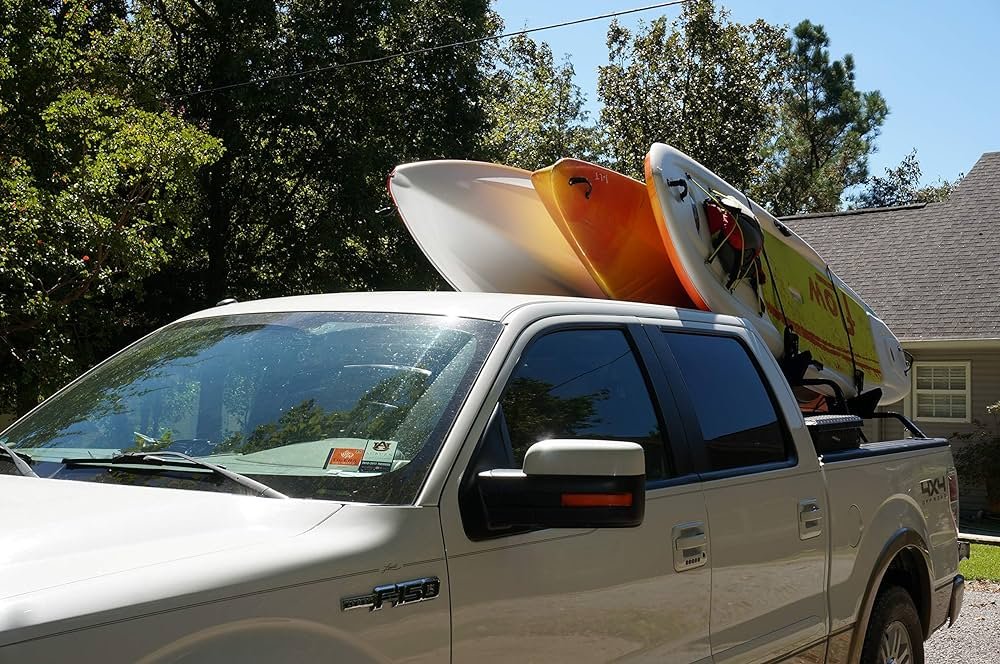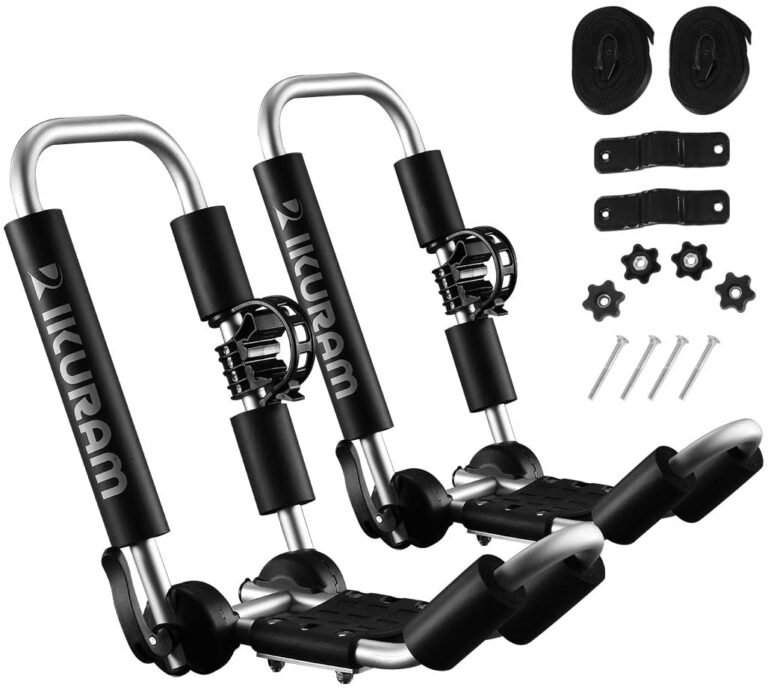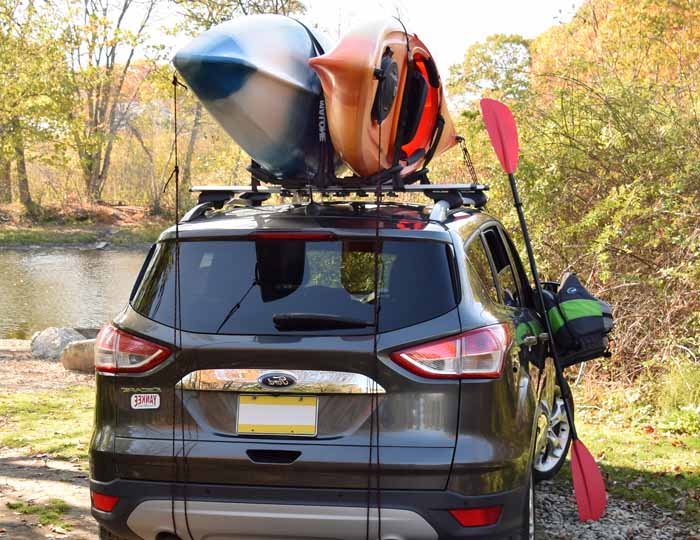Come legare un kayak nel pianale di un camion

Il kayak è uno sport popolare, divertente ed emozionante apprezzato da persone di tutte le età, molte delle quali possiedono kayak e moto d'acqua spinte da pagaie, che sono l'attrezzatura principale di questo divertente sport e gli danno il nome.
Avere un kayak tutto tuo, tuttavia, non è privo di problemi. È necessario mantenerli quando non vengono utilizzati e trasportarli sul sito per l'utilizzo quando richiesto. Sebbene i kayak siano un ottimo modo per uscire ed esplorare la vita all'aria aperta, possono essere difficili da trasportare.
Molte persone scelgono di trasportare i propri kayak in macchina, ma questo può essere una seccatura. Alcune persone scelgono di utilizzare ganci di traino o reti da carico, ma questi metodi richiedono molto tempo e richiedono una certa attenzione.
C'è anche la possibilità di utilizzare un carro attrezzi, ma può essere costoso e potrebbero esserci restrizioni su dove è possibile trainare il kayak. Ciò non significa che non puoi ancora trasporta il tuo kayak con un camion.
I kayak non sono la cosa più semplice da trasportare su un camion. Possono essere ingombranti e occupare molto spazio. Tuttavia, ci sono modi per renderli più facili da gestire. Un modo è utilizzare un porta kayak.
Questi supporti si fissano all'interno del camion e mantengono i kayak in posizione. Un'altra opzione è usare a portapacchi. Ciò ti consentirà di riporre i kayak sul tetto del camion, che è meno ingombrante.
Esistono innegabilmente diversi modi per farlo trasportare un kayak con un camion ma molte persone si sentono più sicure trasportando i loro kayak nel pianale del camion. In questo articolo, esamineremo il processo di fissaggio del tuo kayak sul pianale di un camion per un trasporto sicuro.
Accessori per legare un kayak
Tra i vari modi possibili in cui potresti trasportare il tuo kayak, hai deciso di utilizzare un camion. Grande.
Scegliere un camion significa che puoi procurartene uno e ovviamente hai già un kayak, quindi di quali accessori hai bisogno per far funzionare questa soluzione e trasportare in sicurezza il tuo kayak a destinazione?
- Cinghie o corde elastiche: Per fissare il kayak, hai bisogno di qualcosa con cui legarlo e limitarne il movimento. Puoi usare cinghie o corde elastiche, a seconda di quale sia disponibile e che tu sappia usare. Raccomando i cinturini perché li preferisco.
- Un telo: Proteggere il tuo kayak dagli elementi quando non è in uso è importante affinché il kayak duri ed è per questo che ti serve un telo. Dopo aver assicurato il kayak al pianale del camion, coprilo con il telo per proteggerlo dagli elementi.
- Dispositivo di sollevamento: Se non riesci a sollevare il kayak sul pianale del camion, potresti aver bisogno di un dispositivo di sollevamento per aiutarti. Se non riesci a procurartene uno, non c'è bisogno di farsi prendere dal panico. Basta chiedere aiuto a un vicino e sicuramente riceverai aiuto.
Le cinghie o i fissaggi sono gli accessori più importanti di cui avrai bisogno poiché sono ciò che manterrà il tuo kayak bloccato e sicuro durante il trasporto. Assicurati di usarli bene per fissare il kayak al pianale del camion prima del trasporto.
Come fissare in sicurezza un kayak nel pianale di un camion
I kayak sono ottimi per godersi la vita all'aria aperta, ma non è sempre sicuro lasciarli senza sicurezza nel pianale di un camion. Ecco alcuni suggerimenti su come trasportare in sicurezza il tuo kayak:
- Attacca le cinghie di fissaggio del kayak al telaio del camion o alla lamiera.
- Fissare il ponte del kayak al telaio o alla lamiera con corde elastiche, anelli a D o cinghie attorno al pianale del camion.
- Non sollevare il kayak dal ponte.
- Fissare la prua del kayak al pianale del camion con corde elastiche o anelli a D.
I passaggi per fissare in sicurezza un kayak al pianale di un camion per il trasporto sono elencati e spiegati di seguito.
Passaggio 1: identificare i punti di attacco sul kayak e sul pianale del camion.
Ci sono alcuni punti di attacco di cui avrai bisogno per fissare saldamente il tuo kayak al pianale del camion. Il primo è il supporto di poppa del kayak, ovvero il punto in cui la prua e la poppa del kayak si incontrano.
Il secondo è il supporto di prua del kayak, che si trova sulla parte anteriore del kayak e si attacca al pianale del camion con una cinghia.
Altri punti di attacco si troveranno sul corpo del kayak. Il tuo kayak potrebbe già avere questi punti di attacco per le cinghie. Identifica questi punti sia sul tuo kayak che sul camion. Consentono di fissare saldamente il kayak, impedendogli di muoversi durante il trasporto.
È importante assicurarsi che questi punti di attacco siano sicuri in modo che il kayak non si muova e si danneggi durante il trasporto.
Se il tuo kayak o il tuo camion non hanno questi punti di attacco o non sono abbastanza resistenti, dovresti installarli o sostituirli a seconda della situazione.
Ricorda che se il tuo kayak dovesse cadere durante il trasporto, non solo potrebbe danneggiarsi, ma può anche danneggiarsi provocare incidenti e attirarti guai. È nel tuo interesse assicurarti che il tuo kayak e il tuo camion abbiano entrambi questi punti cruciali e che siano in buone condizioni.
Passaggio 2: carica il kayak sul pianale del camion
Dopo esserti assicurato che il kayak e il camion abbiano entrambi punti di attacco, il passo successivo è caricare il kayak sul pianale del camion. Devi prima assicurarti che il pianale del camion sia pulito e privo di qualsiasi cosa che possa danneggiare la tua moto d'acqua.
Quindi abbassi il portellone del camion e carichi il kayak sul pianale del camion. Dopo aver caricato il kayak, devi assicurarti che sia posizionato nella posizione ottimale per essere assicurato con le cinghie. Per ottenere questa posizione ottimale, allineare la prua dell'imbarcazione con il portellone posteriore.
Quindi inclina la poppa del kayak nell'angolo anteriore sinistro del pianale del camion per ottenere il giusto orientamento. Se hai un pianale più ampio, potresti essere in grado di farlo caricare il kayak senza alcuna necessità di posizionamento.
Passaggio 3: attaccare le cinghie o le corde del kayak al pianale del camion.
Il passo successivo per proteggere il tuo kayak è attaccare le cinghie o le corde del kayak al punto di attacco appropriato. Questo è un punto cruciale poiché le cinghie sono ciò che impedirà al tuo kayak di muoversi durante il viaggio.
Le cinghie devono essere resistenti e fissate saldamente in modo che non possano allentarsi lentamente durante il trasporto. Sebbene fissare il kayak sia importante, fai attenzione perché se non attacchi le cinghie nel punto giusto o non le stringi troppo, potresti danneggiare inavvertitamente il tuo kayak.
Attaccare le cinghie in modo sicuro e con moderazione. Potresti voler utilizzare dei lucchetti per fissare le cinghie al loro punto di ancoraggio solo per essere sicuro. Dopo aver eseguito queste operazioni, sollevare il portellone.
Servirà da firewall contro la caduta del kayak nell'improbabile scenario in cui non lo hai fissato bene. Se il tuo kayak è piuttosto lungo, il portellone posteriore aiuterà anche a sollevare l'eventuale sporgenza del kayak abbastanza in alto da non interferire con altri veicoli o utenti della strada.
Se ci sono molti strapiombi, lega una bandiera (preferibilmente di colore rosso) per consentire agli altri utenti della strada di essere consapevoli dello strapiombo e prendere le precauzioni necessarie per prevenire qualsiasi incidente.
Passaggio 4: stringere le cinghie o le corde per fissare il kayak in posizione.
Stringere le cinghie e ricontrollare che il kayak sia a posto non può essere enfatizzato abbastanza. Questo è ancora più importante se hai legato il kayak al pianale del camion qualche tempo prima e stai uscendo.
Conferma sempre che il tuo kayak sia assicurato prima di intraprendere il viaggio. Non si è mai abbastanza attenti e potresti notare alcuni errori da correggere.
Una volta che sei sicuro che il tuo kayak sia saldamente fissato, puoi fornirgli ombra se desideri proteggerlo dagli elementi durante il tuo viaggio. È possibile procurarsi facilmente un telo e utilizzarlo per proteggere il kayak dalle intemperie.
Ricorda che è necessaria una corretta manutenzione se vuoi che il kayak resista alla prova del tempo e continui a regalarti momenti divertenti sull'acqua.
Potrai quindi procurarti l'attrezzatura e le provviste per il tuo viaggio in kayak. Se sei sicuro che tutto sia pronto, è finalmente il momento di mettersi in viaggio e iniziare la tua prossima emozionante avventura in kayak.
Passaggio 5: controllare periodicamente la tenuta delle cinghie o delle corde durante il trasporto.
Fissi il tuo kayak al pianale del camion utilizzando corde o cinghie e sei finalmente in viaggio per trasportare la moto d'acqua alla destinazione prevista.
Controllare periodicamente la tensione di queste cinghie o corde durante il trasporto può aiutare a garantire che il kayak sia sicuro e non si muova durante il trasporto. Questo passaggio è molto importante soprattutto se stai intraprendendo un lungo viaggio e lo percorri velocemente.
Oltre a garantire che il tuo kayak sia ancora al sicuro senza il rischio di causare incidenti, i controlli periodici ti aiutano anche a valutare lo stato delle cose e ad assicurarti che tutto sia come dovrebbe essere.
Può anche proteggere il tuo kayak da persone che potrebbero guardarlo con avidità quando notano che tieni d'occhio la tua attrezzatura sportiva.
Passaggio 6: arriva a destinazione e rilascia il kayak dal pianale del camion.
Il tuo viaggio si è concluso con successo e sei arrivato sano e salvo a destinazione, ma le cose non finiscono qui. Sei finalmente pronto per la tua prossima avventura in kayak. Prima di poter andare in kayak, tuttavia, è necessario togliere il kayak dal pianale del camion che lo ha tenuto al sicuro durante il trasporto. Ecco 7 semplici passaggi per realizzarlo:
- Aprire il portellone del camion.
- Mettiti nella posizione corretta sul tuo kayak fissando la pagaia nella posizione corretta.
- Rilascia le cinghie che fissano il tuo kayak al pianale del camion.
- Rimuovere tutti gli oggetti sciolti dal pianale del camion.
- Sposta il kayak fuori dal pianale del camion e in un luogo asciutto.
- Indossa il giubbotto di salvataggio, prendi la tua attrezzatura ed entra in acqua!
- Stai sicuro e divertiti!
Possedere la tua attrezzatura in qualunque cosa tu faccia ti dà tranquillità e tutti aspirano un giorno a possederla se non hanno già l'attrezzatura che amano usare. Questo percorso ha portato molti canoisti a possedere il kayak, l'attrezzatura che utilizzano per questo sport che li fa divertire tantissimo.
Naturalmente, con la proprietà di un kayak ne deriva la responsabilità, e i kayakisti spesso devono pulire, riporre e spostare la loro moto d'acqua da un posto all'altro. Esistono diversi modi per trasportare un kayak, ma il trasporto di un kayak su un camion è un'opzione particolarmente praticabile.
Per trasportare un kayak su un camion, devi prima fissarlo al pianale del camion. Assicurati di misurare il kayak e il pianale del camion per assicurarti che si adattino correttamente e utilizza una copertura impermeabile o un telo per proteggere il kayak dagli elementi.
Assicurati di utilizzare molte cinghie per fissare il kayak e assicurati che il letto sia pulito e privo di detriti. Inoltre, prestare attenzione all'altezza del kayak durante il carico e lo scarico. Una volta che sei sicuro che il kayak sia assicurato, puoi guidare fino a destinazione.
Il viaggio dovrebbe essere trascorso guidando con cautela, prestando attenzione all'ambiente circostante ed eseguendo controlli periodici sul kayak e sugli altri attrezzi per assicurarsi che siano ancora sicuri e individuare rapidamente eventuali anomalie che potrebbero verificarsi.
Una volta a destinazione, scarica in sicurezza il kayak e metti in ordine la tua attrezzatura prima di entrare in acqua. Anche se trasportare un kayak non è un compito da scherzare, con un po' di preparazione, trasportare un kayak sul pianale di un camion può essere un processo semplice.
Ricorda di adottare pratiche sicure in kayak, di essere sicuro e di divertirti in acqua. Grazie per aver letto!
Domande frequenti
Qual è il modo migliore per legare un kayak?
Il kayak è un ottimo modo per rimettersi in forma e vedere alcuni degli splendidi paesaggi di tutto il mondo. Esistono diversi motivi per cui vorresti legare un kayak e uno di questi è impedire che la moto d'acqua si muova durante il trasporto.
Esistono molti modi per legare un kayak, ma il modo migliore dipende dalle esigenze e dalle preferenze specifiche del kayaker. Kayak diversi sono progettati per usi diversi e ciascuno viene fornito con la propria serie di requisiti di attrezzatura.
Alcune persone preferiscono usare corde elastiche o teli mentre altri optano per nodi semplici. È importante selezionare un metodo che sia comodo e sicuro per te, il tuo kayak e chi ti circonda.
Un kayak può stare nel pianale di un camion?
I kayak sono diventati popolari come attrezzature per il fitness e per uso ricreativo. Cerchi un modo per trasportare il tuo kayak senza preoccuparti che occupi molto spazio?
Allora potresti prendere in considerazione l'utilizzo di un pianale per camion come opzione di trasporto. I pianali dei camion sono in genere abbastanza grandi da contenere un kayak e molti modelli sono dotati anche di portapacchi che possono contenere altri oggetti.
Se non sei sicuro che il tuo kayak sia adatto, chiama il produttore o controlla online per informazioni sulla compatibilità. Sebbene alcuni kayak siano progettati per adattarsi al pianale di un camion, non tutti lo sono.
Ci sono diversi fattori da considerare prima di decidere se un kayak può stare nel pianale di un camion. Le dimensioni del kayak e la larghezza del pianale del camion sono tutte considerazioni importanti.
Quanto può sporgere un kayak dal pianale di un camion?
I kayak sono sempre più popolari come imbarcazioni da diporto e la loro popolarità ha portato i kayakisti a cercare più posti dove riporre le loro moto d'acqua. Alcuni kayakisti sono arrivati addirittura a far uscire i loro kayak dal retro dei camioncini.
Può un kayak sporgere dal retro del pianale di un camioncino? La risposta è sì, ma non senza alcune modifiche.
Se vuoi mettere un kayak nel pianale di un camion per il trasporto o per lo stoccaggio, allora dovresti sapere quanto ti è consentito tenere il kayak fuori dal tuo veicolo.
Il tuo kayak può rimanere sospeso fino a 4 piedi dal tuo camion senza problemi. Qualunque cosa in più attira guai per l'intruso.
Come si carica un kayak su un camioncino?
I kayak sono ingombranti e difficili da trasportare. Caricarne uno su un camioncino può essere una sfida, ma ci sono alcuni trucchi che possono rendere il processo più semplice.
Individua il piano di carico del kayak e posizionalo tra il paraurti posteriore e il telaio del camion. Quindi, sollevare il kayak sul piano di carico e metterlo in posizione.
Infine, fissa il ponte con cinghie o elastici per mantenerlo in posizione. Un'altra opzione è quella di appoggiare il kayak su un lato nel pianale del pick-up e quindi utilizzare le cinghie per tenerlo in posizione.
Ancora un'altra opzione e forse la migliore è utilizzare un sistema di sollevamento per kayak. Una volta messo il kayak nel camion, puoi fissarlo con le cinghie.






